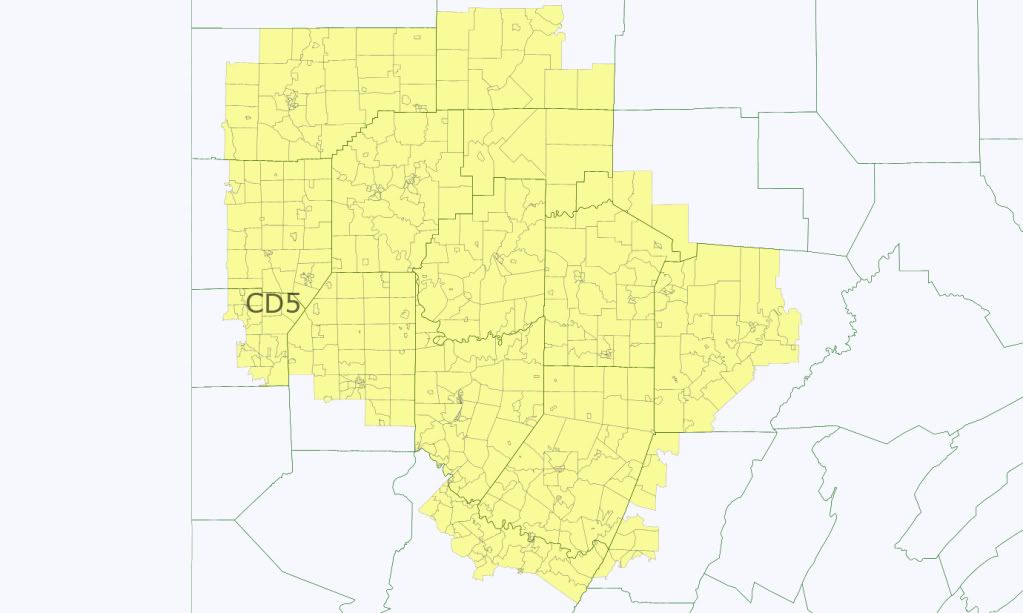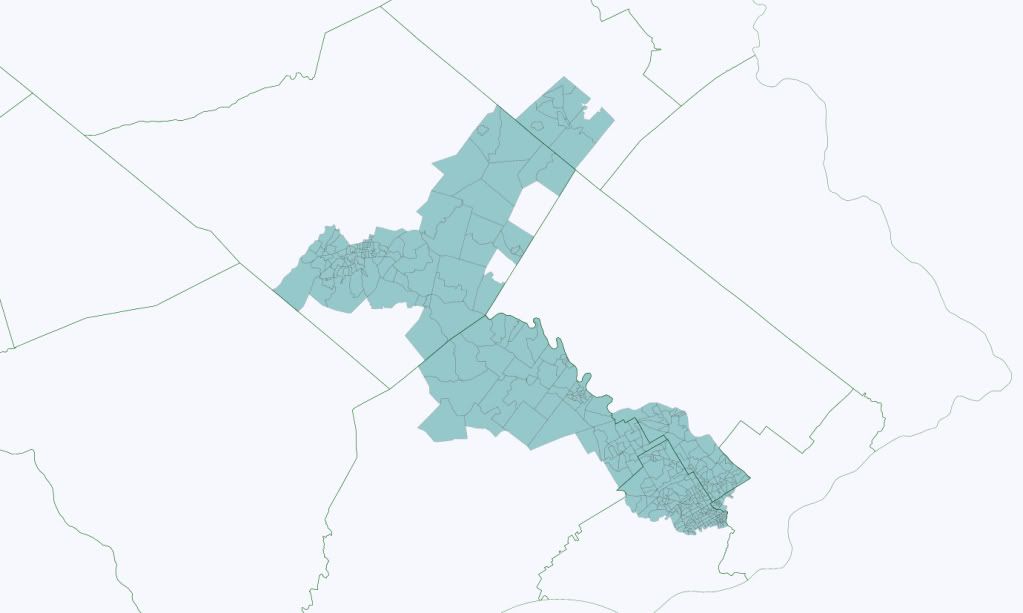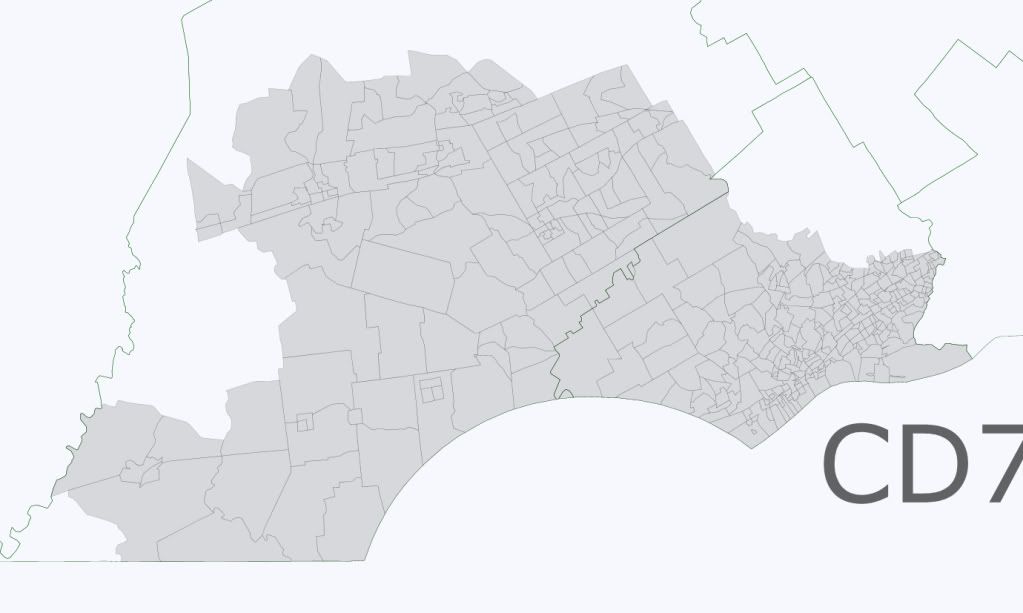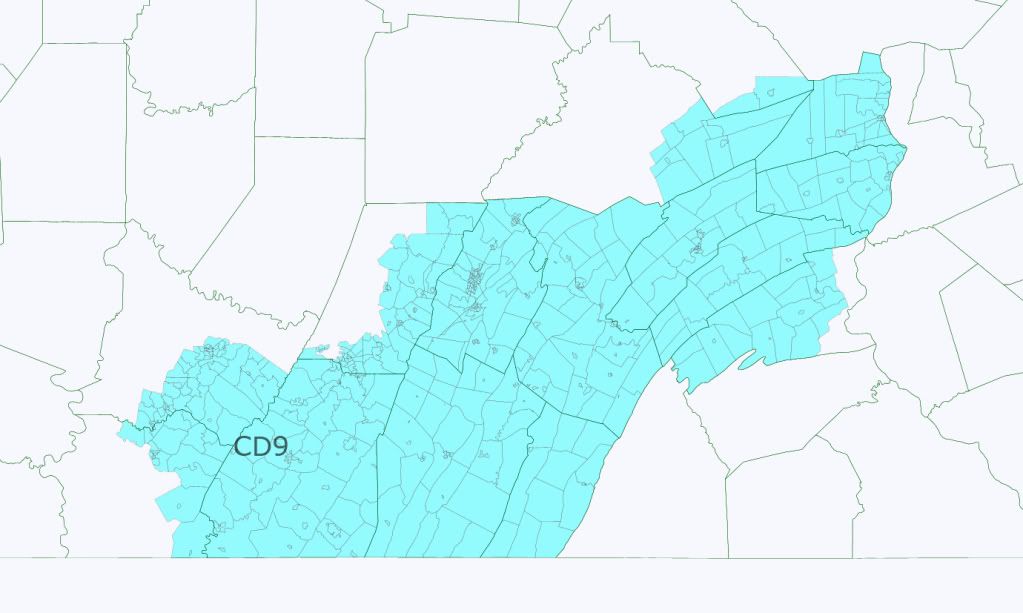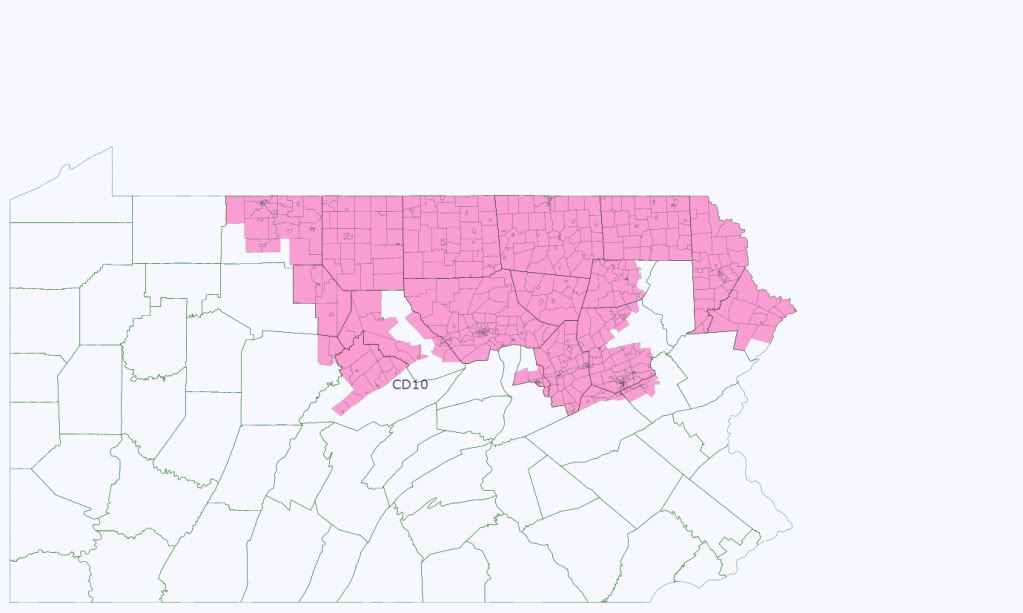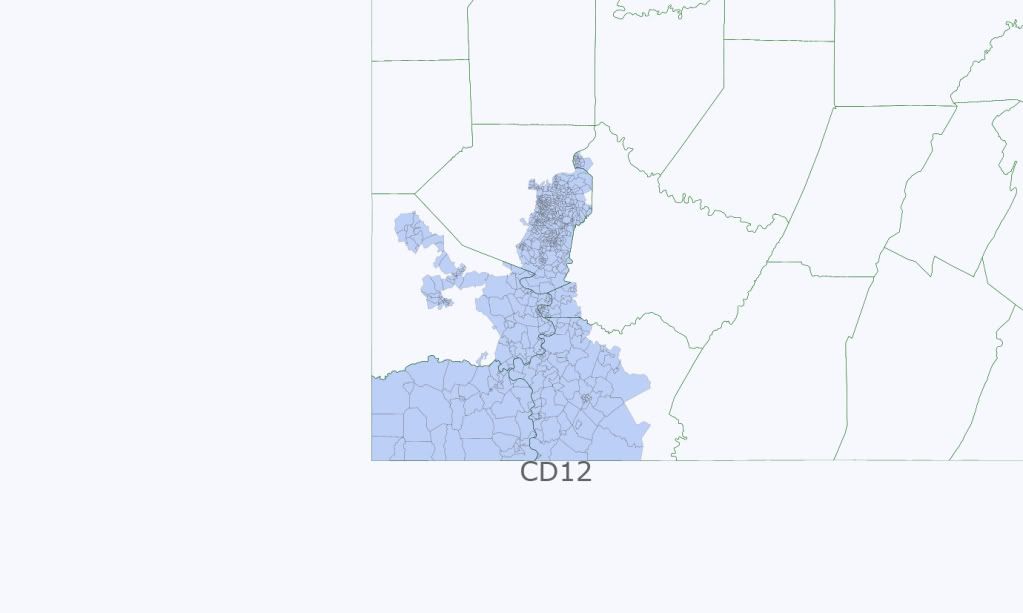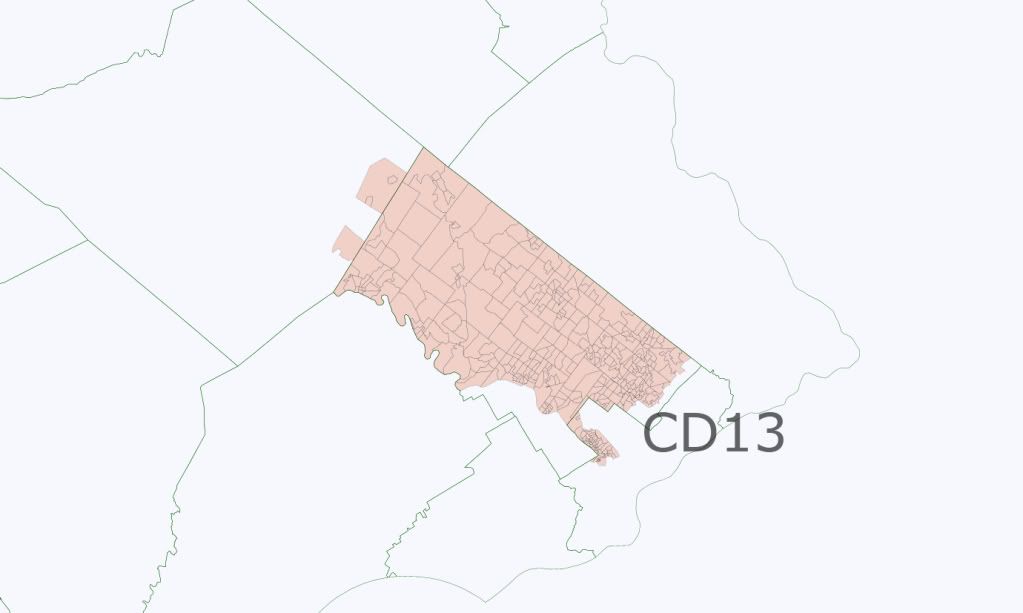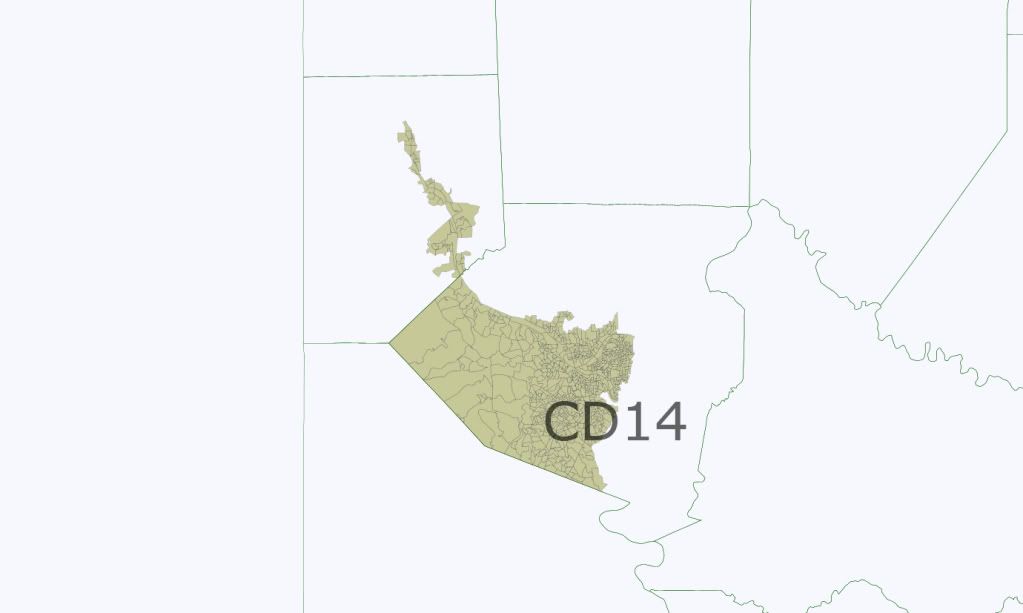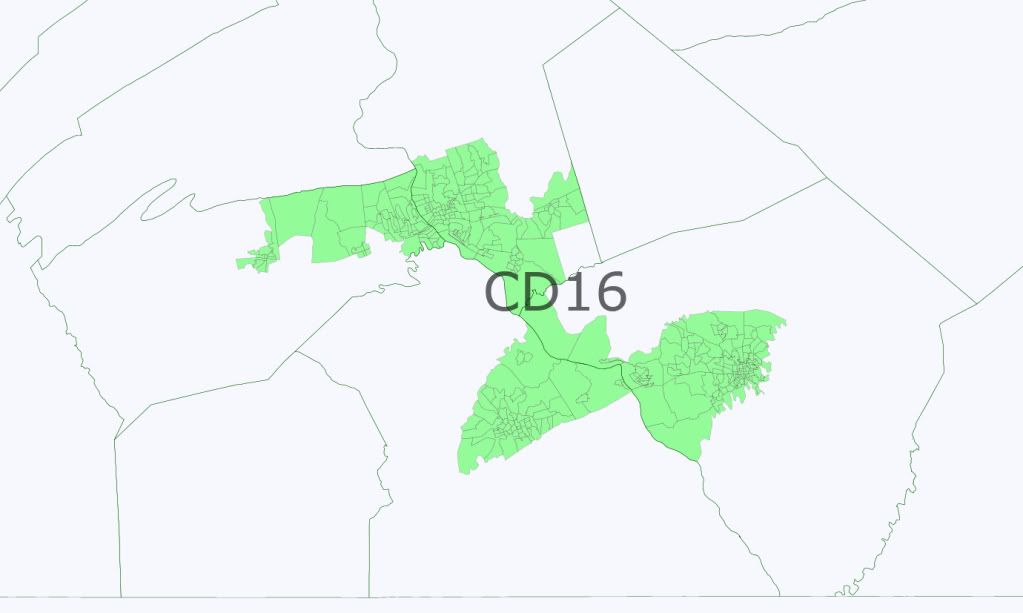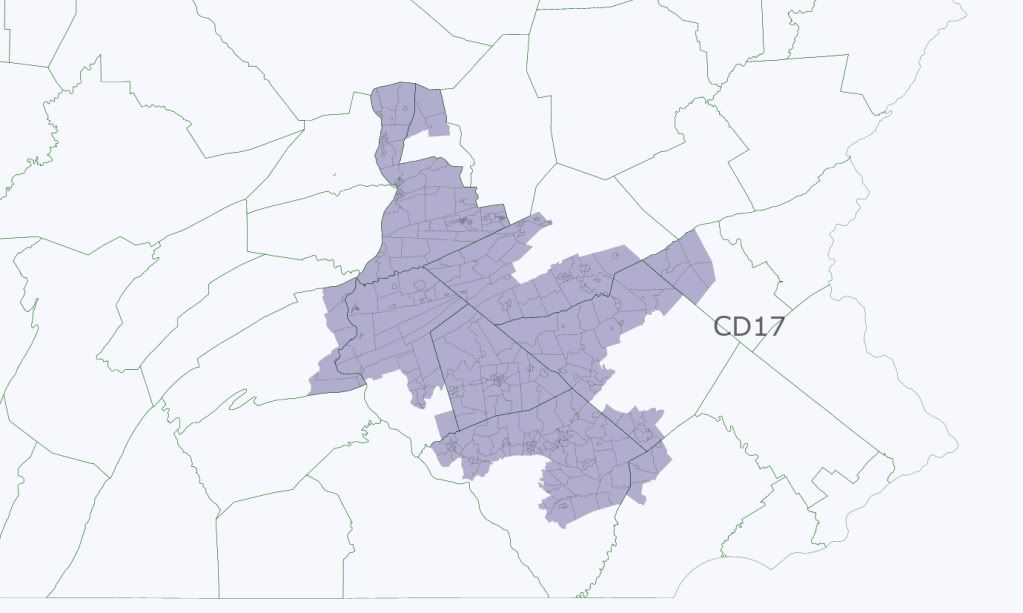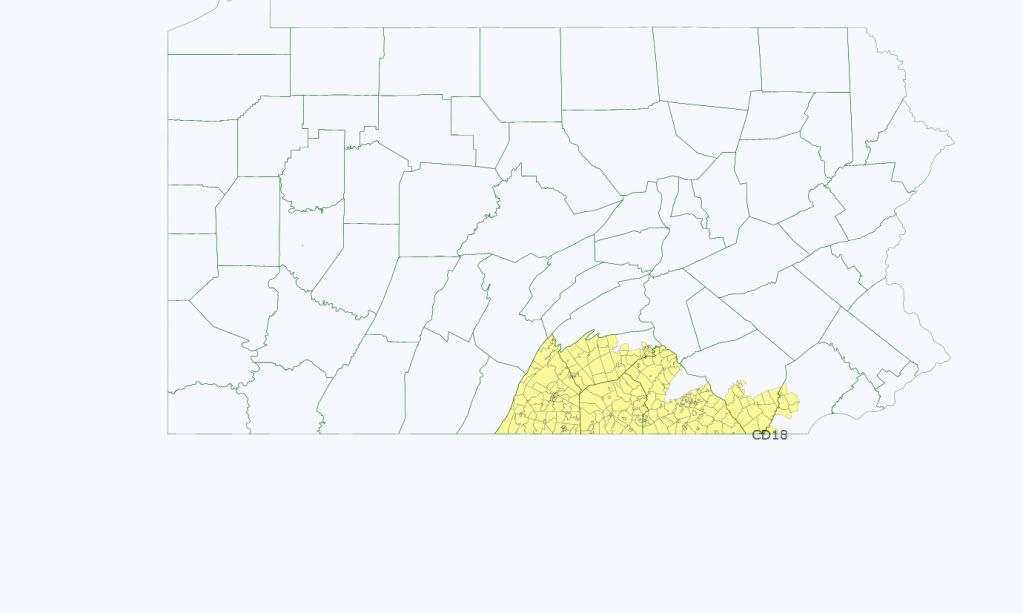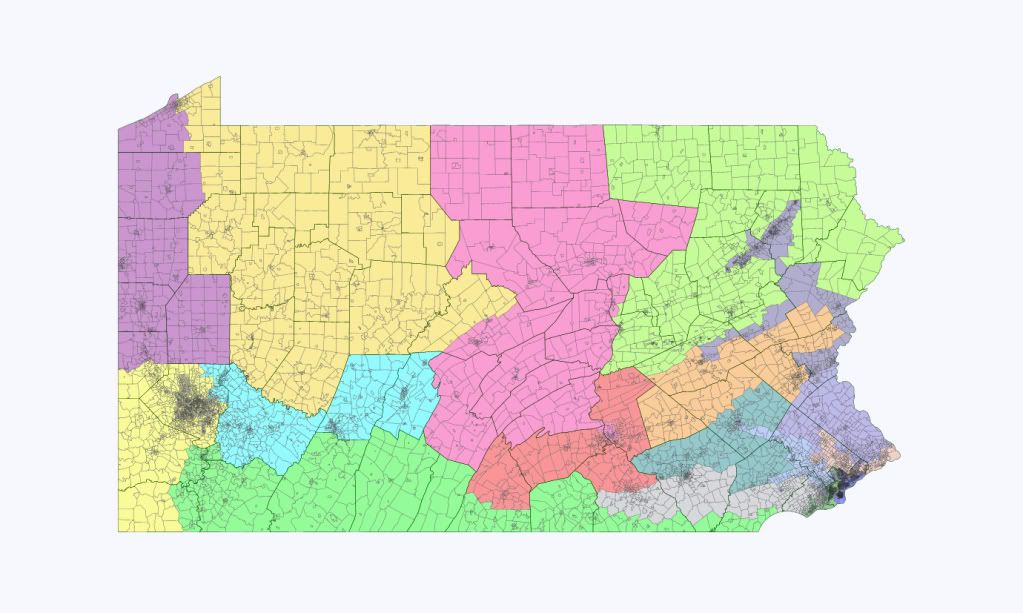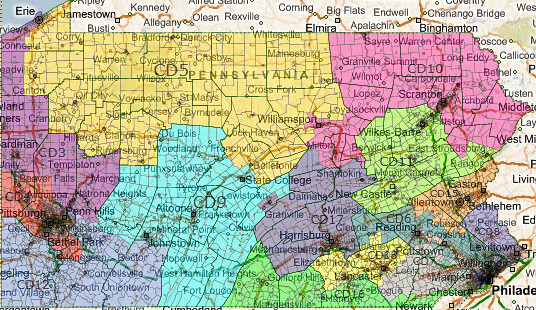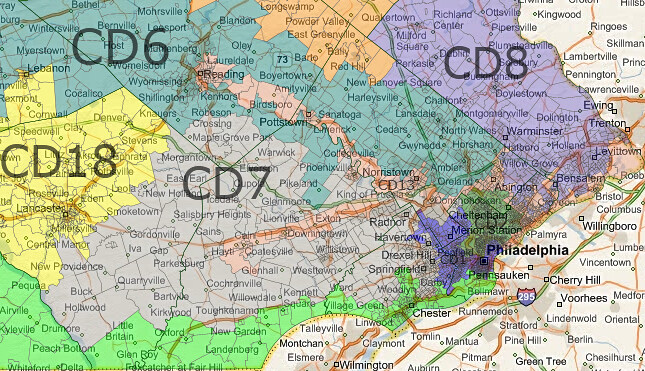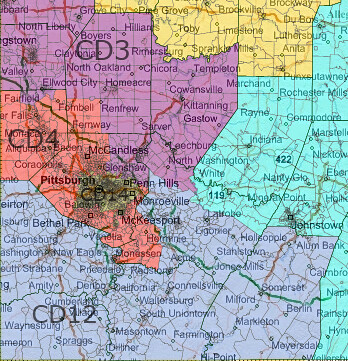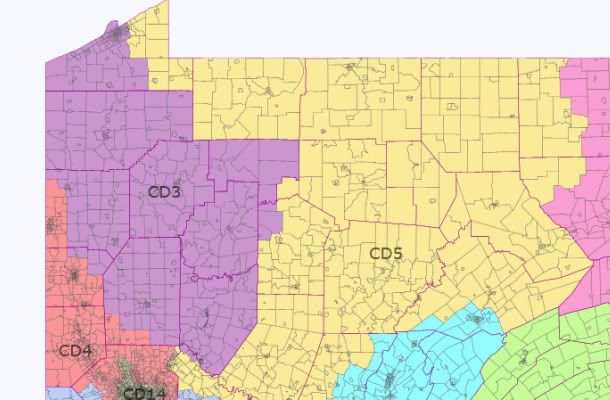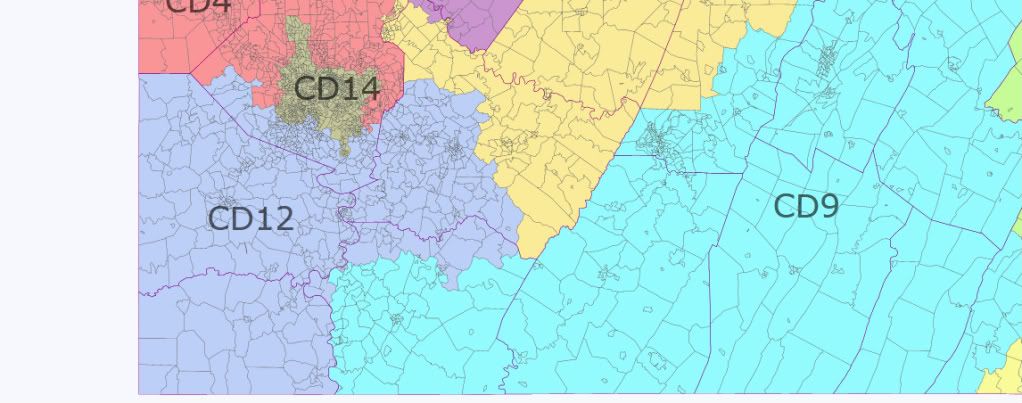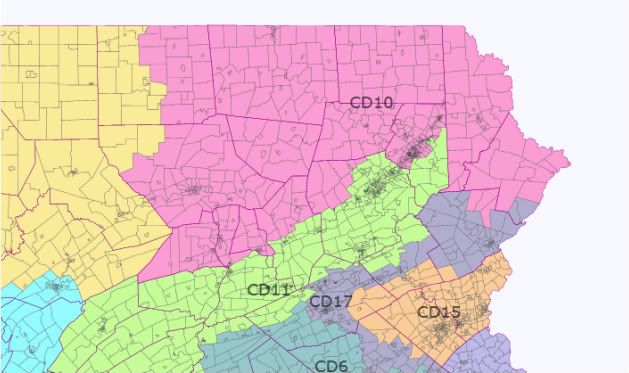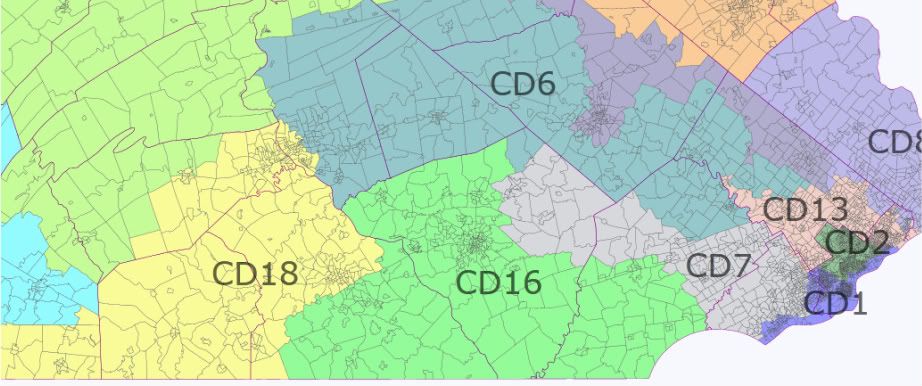Republicans had a great night in Pennsylvania this November, which makes drawing a decent map for them really hard.
The problem for them is, fundamentally, that they won in all the wrong places. They knocked off Carney and Kanjorski, whereas if they’d taken only one of them they could have packed the survivor’s district and used the redder bits of his district to make Charlie Dent a little later. They held PA-6 and took back PA-7 and PA-8, meaning that it’s that much harder to protect their representatives in the suburban Philadelphia area, whereas if the Dems had held one seat then it would have been possible to shift the other districts further from the city.
And they didn’t knock off Critz or Altmire, meaning that they’ll have to work a little harder to give them unwinnable districts.
All in all, they’d have a lot more options for the coming redistricting if they’d won a few less districts and if more of them had been in western PA.
But what’s done is done. Republicans can enjoy their gains for now and they’ll just have to work to try to keep them – because there’s no way they’ll willingly concede seats in the next redistricting.
This map is an attempt to strengthen the Republican freshmen and to eliminate the last two Democratic representative in western Pennsylvania outside Pittsburgh. By giving Tim Holden a reasonably strong Democratic district, it frees up enough red territory to give the Republicans a fighting chance of a 13-5 advantage out of the state.
But this is not without risk. McCain got beaten by ten points in Pennsylvania and five Republicans in this new map will represent districts he lost. If they all flipped, Democrats would have a 10-8 advantage out of the state. If Joe Pitts can’t adapt to his new district, it could be as bad as 11-7.
On the other hand, it’s almost impossible to defend all twelve Republican congressmen in the state effectively. This map improves the prospects of each Republican in a district Obama won by at least four points net. I won’t pretend this map doesn’t have weaknesses, but it’s probably the best the Republicans can do.
As an added challenge, I endeavoured to keep townships together, as I don’t think the advantage gained by splitting them outweighs the negative press received for doing so. This doesn’t apply in Philadelphia, as the Republicans have no reason to care about a backlash there.
I would have like to be able to give Sestak-Toomey results, as it’d establish how safe these seats would be in a good year (i.e. if Joe Pitts’ district would still have been a bit marginal this year then he might be in trouble either way), but sadly not all counties have put up results by precinct yet. Most have, but several important ones like Montgomery and Erie haven’t, so sadly we lack that method of double-checking.


PA-1
Incumbent: Bob Brady
Population |
White |
Black |
Hispanic |
Asian |
|---|
684861 |
35 |
50 |
8 |
5 |
|
Obama % |
McCain % |
|---|
Old lines |
88 |
12 |
|---|
New lines |
87 |
12 |
|---|
% change |
-1% |
+0% |
|---|
Like I said, redistricting isn’t going to be as much fun for the Republicans as it might have been. If they want to enjoy themselves, they’ll have to make their own entertainment.
In this map I represented that by drawing the new PA-1 as minority-majority (which the Republicans would be mad not to try for, as with no retrogression they can create two Democratic vote sinks that will be almost impossible to eliminate).
I also noted that according to his candidate petitions Bob Brady lives in Ward 34 Precinct 34, which is on the very western edge of West Philadelphia. I therefore slipped it into Allyson Schwartz’s district.
Now, Bob Brady is quite capable of moving a few blocks back into the district, assuming election law actually requires him to. And he’s represented a minority-majority district for long enough that making it 50% black won’t have him quaking in his boots. But still, Republicans have to get their giggles somehow. And spite is the gift that keeps on giving.
The district itself is somewhat less interesting. It keeps its strip through southern Delaware County to Chester, as well as the areas of Darby, Yeadon and Sharon Hill, and combines these these with south, west and central Philadelphia, together with portions of north Philly and much of Kensington.
PA-2
Incumbent: Chaka Fattah
Population |
White |
Black |
Hispanic |
Asian |
|---|
685048 |
34 |
50 |
10 |
3 |
|
Obama % |
McCain % |
|---|
Old lines |
90 |
10 |
|---|
New lines |
88 |
12 |
|---|
% change |
-2% |
+2% |
|---|
Chaka Fattah is harder to draw out, so Republicans will have to settle for just giving him the biggest district in the state population-wise.
There’s very little to say about this district. It narrowly remains above 50% black and takes in the rest of Philadelphia, bar small portions of the Northeast and Northwest. Much of it is new to Fattah, but I can’t imagine him facing too many problems with it.
PA-3 (was PA-13)
Incumbent: Allyson Schwartz, Bob Brady, Patrick Murphy
Population |
White |
Black |
Hispanic |
Asian |
|---|
681192 |
83 |
8 |
3 |
4 |
|
Obama % |
McCain % |
|---|
Old lines |
59 |
41 |
|---|
New lines |
64 |
35 |
|---|
% change |
+5% |
-6% |
|---|
It’d be much easier to pack the Democratic vote if the Philadelphia suburbs hadn’t elected so many Republicans this year. As a result, the task is largely left to Schwartz, who gets a district that’s absolutely safe in the hope she doesn’t get ideas like running for governor any time soon.
I’ve renumbered the districts, because if you’re going to gerrymander you should at least care enough to cover your tracks by numbering the districts in a vaguely logical order (even if my order does involve flying betwen north and south Pennsylvania like a fairground ride.)
The district keeps its core in southern Montgomery County and Northeast Philadelphia, although much of northern Montgomery is moved elsewhere. To this it adds Northwest Philadelphia west of Wissahickon Creek and north of Cresheim Creek, plus Bensalem southern parts of Levitttown in Bucks County. In doing so, it also mops up the home of Patrick Murphy, in an attempt to keep him out of Fitzpatrick’s hair.

PA-4 (was PA-8)
Incumbent: Mike Fitzpatrick
Population |
White |
Black |
Hispanic |
Asian |
|---|
682279 |
92 |
2 |
2 |
2 |
|
Obama % |
McCain % |
|---|
Old lines |
54 |
45 |
|---|
New lines |
52 |
47 |
|---|
% change |
-2% |
+2% |
|---|
Fitzpatrick’s district is improved by four points net and Murphy is removed from his district. That said, it’s not all smiles for him.
Swapping southern Bucks for reddish or marginal parts of eastern and northern Montgomery helps him a little. On the other hand, he could be helped a lot more if the last 35,000 of his population requirement didn’t have to be filled by taking Easton off Charlie Dent’s hands.
This district is slightly more Republican than the nation as a whole, and if Fitzpatrick endears himself to his constituents he could well survive. On the other hand, he has to be hoping Sarah Palin gets nowhere near the Republican nomination. The last thing he needs in 2012 is a combination of presidential year turnout and a candidate guaranteed to drive suburban voters into voting for Democrats.
PA-5 (was PA-6)
Incumbent: Jim Gerlach, Manan Trivedi
Population |
White |
Black |
Hispanic |
Asian |
|---|
680512 |
90 |
3 |
3 |
3 |
|
Obama % |
McCain % |
|---|
Old lines |
58 |
41 |
|---|
New lines |
53 |
46 |
|---|
% change |
-5% |
+5% |
|---|
Jim Gerlach is never going to be entirely safe, but this district might give him a bit of extra comfort for a couple of cycles.
Like Fitzpatrick, he has to help Dent out in the Lehigh Valley, in Gerlach’s case grabbing Bethlehem plus southern portions of Lehigh and Northampton counties. Nevertheless, these areas aren’t overwhelmingly blue and in all other cases boundary changes are in his favour.
He gives up much of Chester County to let the new PA-6 through and abandons Reading and its most Democratic suburbs to Tim Holden.
In return, he picks up absolutely blood-red, 70-30 McCain areas in northwest Berks and northeast Lancaster, which are less likely to turn blue suddenly than his current suburban turf.
PA-6 (was PA-7)
Incumbent: Pat Meehan
Population |
White |
Black |
Hispanic |
Asian |
|---|
679961 |
90 |
5 |
2 |
3 |
|
Obama % |
McCain % |
|---|
Old lines |
56 |
43 |
|---|
New lines |
51 |
48 |
|---|
% change |
-5% |
+5% |
|---|
Pat Meehan is probably the big winner on this map, which is largely accidental, as I figured that if there had to be a Republican casualty in the southeast, he’d be first in line as a freshman who hadn’t previously served in Congress.
His district moves a net ten points towards Republicans. Well, I say his district. Rather than being centred on Delaware County, it now draws less than 250,000 from that source. In the process, it has offloaded the homes of Sestak and Bryan Lentz to Joe Pitts’ district.
It makes up for this by heading west through the central parts of Chester county, turning northwestwards and heading through Lancaster county into southern Lebanon county and eastern Dauphine county, finishing up in the outer suburbs of Harrisburg.
With no part of the district outside Delaware County large enough to provide a base for primary challengers and with a lot of new turf that won’t turn blue in a hurry, Pat Meehan can afford to feel very pleased with himself.
Until he realises that Obama still won this district, so he can’t feel entirely comfortable.
PA-7 (was PA-16)
Incumbent: Joe Pitts, Joe Sestak, Bryan Lentz
Population |
White |
Black |
Hispanic |
Asian |
|---|
681623 |
91 |
4 |
3 |
1 |
|
Obama % |
McCain % |
|---|
Old lines |
48 |
51 |
|---|
New lines |
49 |
51 |
|---|
% change |
+1% |
+0% |
|---|
Although he represents the first district we’ve yet seen that McCain won, Joe Pitts is probably the biggest Republican loser on this map.
It’s not drastic in terms of pure partisanship. Obama improves by only 1% compared to the old lines. But whilst he’s dropped Reading and Lancaster and picked up reliably red turf in southern York County, he’s also absorbed a little over 200,000 new largely Democratic voters in Delaware County.
If he’s ready to adapt himself to a more suburban audience, he’ll do fine. McCain won the new district and it’s likely Bush did so with huge margins. But if he can’t do that and if Joe Sestak fancies running for Congress again, there could be problems for Pennsylvania Republicans.
PA-8 (was PA-17)
Incumbent: Tim Holden
Population |
White |
Black |
Hispanic |
Asian |
|---|
683263 |
77 |
9 |
10 |
2 |
|
Obama % |
McCain % |
|---|
Old lines |
48 |
51 |
|---|
New lines |
56 |
43 |
|---|
% change |
+8% |
-8% |
|---|
This isn’t, I will admit, a pretty district, but it’s a functional one. The cities of Lancaster, Harrisburg, Lebanon, Pottsville and Reading are joined by stretches of extremely red countryside, forming the semblance of an M, then parts of central Schuykill are shoved in to make sure Holden runs here.
A community of interest district of south-eastern Pennsylvanian cities that don’t simply look to Philadelphia is created, Tim Holden gets a much safer district, but a progressive enough one for him to be troubled in the primary and Republicans get to take vast red areas from his current district, as well not having to face up to him in the general election. Everybody wins, except the 30% Obama areas that get their voting preferences drowned out by the cities.
PA-9 (was PA-15)
Incumbent: Charlie Dent
Population |
White |
Black |
Hispanic |
Asian |
|---|
681623 |
88 |
3 |
7 |
1 |
|
Obama % |
McCain % |
|---|
Old lines |
56 |
43 |
|---|
New lines |
54 |
45 |
|---|
% change |
-2% |
+2% |
|---|
This district isn’t as much as an improvement as some, but Charlie Dent won’t be too disappointed. His new territory in the Poconos went for Obama, but Pat Toomey won it by over 5,000 votes and the Coal County portions of the district went narrowly for McCain.
In the old core of the district, meanwhile, his margins are hardly hurt by exchanging Easton and Bethlehem (and his last challenger) for red bits of north Berkshire County is hardly going to hurt.
Of course, Dent has always won fairly easily by keeping his head down and he might suffer some backlash from this fairly deliberate attempt to carve up the Lehigh Valley. But I doubt that’ll do him enough damage to cancel out the four-point net Republican improvement in this district.
PA-10 (was PA-11)
Incumbent: Lou Barletta
Population |
White |
Black |
Hispanic |
Asian |
|---|
680221 |
97 |
1 |
1 |
1 |
|
Obama % |
McCain % |
|---|
Old lines |
57 |
42 |
|---|
New lines |
52 |
47 |
|---|
% change |
-5% |
+5% |
|---|
Let’s be honest here – Paul Kanjorski was a terrible candidate. He nearly lost a district that Obama won by fifteen points in 2008, and followed that up by a ten-point defeat against the same opponent in 2010, whilst Joe Sestak carried the district by four points.
Given a better year for Democrats and a better candidate like Corey O’Brien, Barletta could be in real trouble. The district is therefore heavily reconfigured. Swingy Carbon and Monroe Counties are given to Dent, whilst in Lackawanna County it abandons Scranton (and O’Brien’s residence in Moosic) to the 11th, whilst absorbing most of the 11th (old 10th)’s portions of Lackawanna County, as well as the entirety of Wyoming County.
In the south-west of the district, it expands to take in much of the Coal Region, including the entirety of Northumberland and Montour counties, northern Dauphin and northwest Schuykill.
It’s still a district Obama won, although the margin is slightly less than he managed nationally. But without the Democratic juggernaught of Scranton and with downscale and monolithically white coal counties which ought to be sympathetic to his immigrant-baiting populism, Barletta might just have a chance of holding on past 2012.
PA-11 (was PA-10)
Incumbent: Tom Marino, Chris Carney, Corey O’Brien
Population |
White |
Black |
Hispanic |
Asian |
|---|
680774 |
94 |
2 |
1 |
1 |
|
Obama % |
McCain % |
|---|
Old lines |
45 |
54 |
|---|
New lines |
46 |
53 |
|---|
% change |
+1% |
-1% |
|---|
Chris Carney performed very strongly in his portion of Lackawanna County, but he got beaten by at least ten points everywhere else. There’s no great shame in that, as they’re all red counties and he outperformed Joe Sestak by at least 5% in every single one of them, but he did lose pretty big.
Carney initially won by the simple expedient of running in a very strong Democratic year and facing an incumbent who choked his mistress. He retained his position in 2008 by maintaining a very conservative voting record. But this isn’t a very Democratic district and Marino ought to be able to hold on here with ease.
I therefore didn’t feel any great need to concentrate on making Marino too safe. I gave him the rest of Lycoming County to build his base and he also picked up Perry, Juniata and Mifflin counties, which whilst small are also the most Republican in Pennsylvania. These advantages, however, are more than outweighed by the loss of Wyoming County, the addition of a section of Centre County (including State College) that went for Obama by 15 points and Scranton.
Obama won the Lackawanna parts of the district by 32 points. McCain won the rest by 13 points. So it’s not like my attempts at diluting Scranton’s votes are subtle. But it ought to work, especially since Carney’s path to a rematch is likely to be blocked by a primary with a Lackawanna Democrat and since many of the primary voters will be further to the left than the Blue Dog Carney.
PA-12 (was PA-19)
Incumbent: Todd Russell Platts
Population |
White |
Black |
Hispanic |
Asian |
|---|
682014 |
92 |
3 |
3 |
1 |
|
Obama % |
McCain % |
|---|
Old lines |
43 |
56 |
|---|
New lines |
41 |
58 |
|---|
% change |
-2% |
+2% |
|---|
I didn’t set out to strengthen Platts, but given the strength of the red turf around him it was hard not to. His district loses much of York County to give Joe Pitts a chance and compensates by grabbing the rest of Cumberland County plus Franklin County.
Except for York and a very few Harrisburg suburbs, there’s pretty much no Democratic strength in the district.
That said, it’s neither an overly cohesive nor a pretty-looking district. Franklin County doesn’t really belong in s South Central Pennsylvania district and the lines in York are as bad as they are because I had to preserve Platts’ home in the district.
If Republicans pick a more cautious option, expect them to concede a seat in the Delaware County area and combine Pitts with Platts. Platts’ occasional outbursts of sanity would surely doom him in the primary and it’d be possible to draw much neater lines.
For that matter, I wouldn’t be shocked if Republicans drew Platts out of here anyway and replaced him with somebody more reliably obstructive.

PA-13 (was PA-9)
Incumbent: Bill Shuster, Mark Critz
Population |
White |
Black |
Hispanic |
Asian |
|---|
680879 |
96 |
2 |
1 |
0 |
|
Obama % |
McCain % |
|---|
Old lines |
35 |
63 |
|---|
New lines |
42 |
57 |
|---|
% change |
+7% |
-6% |
|---|
Removing Mark Critz really isn’t that difficult. He lives in Johnstown and derives his margin of victory from parts of Cambria County plus the towns along the Monongahela River.
By throwing all of Cambria County into the new 13th, which otherwise takes only a few small and red-leaning parts of Armstrong and Indiana from the old 12th, he’s left with a district a net fourteen points more Republican than the one he currently has. Meantime, Shuster keeps all his old base.
Otherwise, this district is basically just a much less ugly version of the old 9th. County fragments are reduced, with the district no longer taking in any of Fayette or heading north-west through the Appalachians towards Harrisburg. Spurs towards the Allegheny Plateau and Pittsburgh make it a little less compact than it might otherwise have been, but it’s a long way from the worst district on this map.
In the process, it goes from being a 35% Obama to a 42% Obama district, but there’s really not much need for an R+17 district in Pennsylvania. R+10 or so is fine.
PA-14 (was PA-5)
Incumbent: G. T. Thompson, Kathy Dahlkemper
Population |
White |
Black |
Hispanic |
Asian |
|---|
683996 |
95 |
3 |
1 |
0 |
|
Obama % |
McCain % |
|---|
Old lines |
44 |
55 |
|---|
New lines |
46 |
52 |
|---|
% change |
+2% |
-3% |
|---|
The most populous district designed for a Republican, this district remains broadly similar to the old 5th, it just shifts a county or so north-west.
In the process, the city of Erie is drawn into the district. Without Erie, the district is actually even more Republican than before (the removal of State College to the 11th helps). With it, the district moves towards the blue team, although as there’s a lack of Democratic strength anywhere in it outside the north-west of the district, it shouldn’t be overly vulnerable.
Kathy Dahlkemper lives here, but most of the district is new to her and the rest of the district could be won by just about any Democrat, so there’s no reason to assume she’d be the obvious 2012 challenger.
PA-15 (was PA-3)
Incumbent: Mike Kelly
Population |
White |
Black |
Hispanic |
Asian |
|---|
681691 |
94 |
4 |
1 |
0 |
|
Obama % |
McCain % |
|---|
Old lines |
49 |
49 |
|---|
New lines |
47 |
51 |
|---|
% change |
-2% |
+2% |
|---|
I know almost nothing about Mike Kelly, so if he’s a complete nutter then you might need to give him a safer district. If he’s at least somewhat sub-Bachmann, however, this district, which maintains the core of the old 3rd, ought to be defensible by him.
Residual Democratic strength in Lawrence and Beaver Counties might cause him a little problem initially, but at least on a presidential level Democratic strength is already limited to the areas bordering the Ohio, Beaver and Shenango rivers, and if he’s still around by the end of the decade then Democratic strength in western PA may be a bygone memory.
PA-16 (was PA-4)
Incumbent: Jason Altmire, Keith Rothfus
Population |
White |
Black |
Hispanic |
Asian |
|---|
682825 |
96 |
2 |
1 |
1 |
|
Obama % |
McCain % |
|---|
Old lines |
44 |
55 |
|---|
New lines |
42 |
57 |
|---|
% change |
-2% |
+2% |
|---|
Altmire just hung on this year, but the unwinding of Democratic strength in the west will make his job a little harder everyday. This map just aims to make it that little bit harder.
Beaver and Lawrence counties, which still vote Democratic downticket, are replaced by large chunks the considerably more Republican Westmoreland County. Of the seven state representatives representing Westmoreland-based districts in the general assembly, Democrats hold two that was uncontested and one that was contested this year, Republicans hold three (including one gain), whilst the seventh representative was nominated by both parties, so the downticket trend is clearly well-advanced there.
In Allegheny, most of the land north of Pittsburgh and the rivers is taken, except for a small area in the north-east that I dumped into the 13th. South of the Ohio, a thin line of swingy tonwships is also taken to help out Tim Murphy.
This might not finish off Altmire entirely – you’d need to dissect his base and doing so could endanger somebody else – but it’ll make his life more difficult and make him that much more vulnerable to bad Democratic years.
His 2010 challenger, Keith Rothfus, remains in the district, but other and more intimidating candidates might emerge.
PA-17 (was PA-14)
Incumbent: Mike Doyle
Population |
White |
Black |
Hispanic |
Asian |
|---|
684659 |
74 |
21 |
1 |
2 |
|
Obama % |
McCain % |
|---|
Old lines |
70 |
29 |
|---|
New lines |
69 |
30 |
|---|
% change |
-1% |
+1% |
|---|
Doyle’s district maintains its original core of the city of Pittsburgh and some close suburbs, but to achieve population equality and to screw over Mark Critz whilst protecting Tim Murphy, it then heads down the Monongahela valley, taking in parts of Allegany, Washington, Westmoreland, Fayette and Green counties and reaching almost to the West Virginia border. No townships are split, which is the reason the district becomes slightly less Democratic.
The district remains entirely safe, and the other half of Mark Critz’s base is securely esconced in a Democratic district.
PA-18
Incumbent: Tim Murphy
Population |
White |
Black |
Hispanic |
Asian |
|---|
683653 |
95 |
2 |
1 |
1 |
|
Obama % |
McCain % |
|---|
Old lines |
44 |
55 |
|---|
New lines |
46 |
53 |
|---|
% change |
+2% |
-2% |
|---|
Murphy takes, somewhat obviously, everything that’s left. This basically consists of non-riverine portions of Fayette, Greene and Washington, south-east Westmoreland and much of south and south-west Allegheny.
Whilst it does get a little more Democratic, Murphy has represented most of this area for long enough not to face too many problems.
– – – – – – – –
I think it will have become clear by now where the major weaknesses with the map lie. How long can the GOP hold on to suburban Philadelphia seats that are trending against them, and would it be smarter just to give them up? How do you get three Republicans out of the Lehigh Valley and the north-east without making yourself very vulnerable to waves? Is it safe to split Erie County? How much do you have to weaken Altmire to guarantee his defeat? How much duct tape will be needed to shut up Joe Pitts?
I’d guess that at some point towards 2020 this map will be 10-8 Republican at best. It could get even worse. But I can’t see them abandoning any of their incumbents, so they have relatively little choice.
Suggestions as to how they can do this better are, of course, gratefully received





